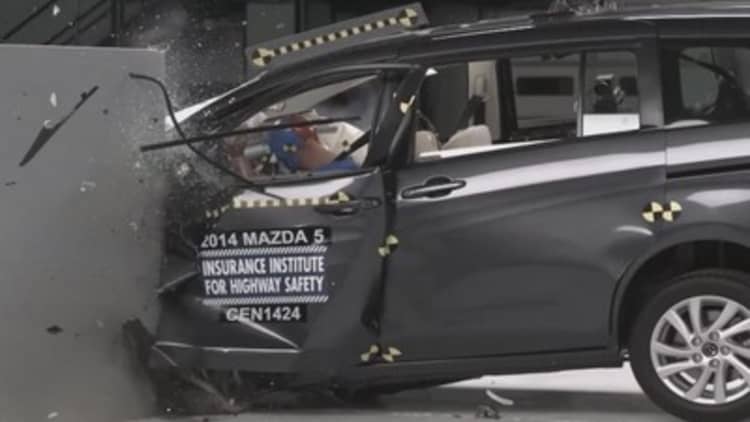More than 30,000 Americans are killed in highway crashes each year, but experts believe that death toll could be eliminated as safety improvements continue and autonomous cars hit the road.
A sign of that possibility will come with the release of a new study next month by the Insurance Institute for Highway Safety, which will show a record number of vehicle models experienced no deaths during the study period from 2009 through the end of 2012.
"It's a tall order," said Russ Rader, the institute's senior vice president for communications. "But the goal is definitely feasible. We're already seeing this happen."
Give credit, Rader said, to the significant improvements in both passive and active safety. A look at the results of crash tests run by the insurance trade group and the National Highway Traffic Safety Administration reveals that today's vehicles are far more likely to survive even the most serious crashes with occupants able to walk away, often without serious injury.
Read MoreElectric car batteries pass latest crash tests
When the institute introduced its small overlap crash test a few years ago, only a few large vehicles were able to protect passengers satisfactorily. The number of models is improving every year. The 2015 subcompact Honda Fit failed badly when it first went through the test—designed to simulate hitting a pole or the corner of an oncoming car. This month, an upgraded Fit passed with flying colors, earning the organization's Top Safety Pick rating.
Credit an improved bumper, which Honda says it will retrofit on early versions of the 2015 Fit for free. It's just one of the many passive safety technologies that have been incorporated into vehicles to reduce injuries when a crash occurs.
In some cases, these improvements are the result of federal mandates, such as the tougher roof crush standard NHTSA recently enacted to improve a person's chances of surviving rollover crashes. But where the industry mantra was once "safety doesn't sell," manufacturers now recognize the opposite is true—and they're racing to come up with newer and better features to protect occupants.
More from The Detroit Bureau:
New carbuyers increasingly dissatisfied
Cadillac may movefrom Motor City to the Big Apple
More than 100 filedeath claims linked to faulty GM ignition switch
Ford is now offering a combination airbag and seatbelt for backseat passengers in a number of its new models, such as the Flex "people-mover." Volvo, which has a goal of having no one killed or seriously injured in one of its cars by 2020, said its new testing environment in western Sweden was specifically designed to allow it to try out new safety systems.
"You can simulate all types of real-world traffic scenarios," said the facility's CEO, Pether Wallin. "At most proving grounds, the options are more limited."

Passive systems are critical to ensuring the safety of vehicle occupants when a crash occurs, but the industry is putting growing emphasis on so-called active safety systems designed to prevent crashes in the first place.
Electronic stability control, or ESP, now required on all passenger vehicles sold in the U.S. "is having a stunning effect in reducing crashes and crash deaths" by preventing the sort of slides and skids that were all too common in the past, Rader said.
Read MoreTake the wheel please, I'm done driving
But that's only a starting point. A growing number of vehicles are now equipped with radar-guided collision avoidance systems that can, for example, detect if another vehicle might run a red light ahead of you. Even more advanced technology can automatically apply the brakes if the driver doesn't respond quickly enough.
The completely redesigned Mercedes-Benz launched last year is a technological showcase, even featuring infrared night vision that can spot a deer, dog or pedestrian.
There is a price to be paid. By various estimates, motorists are paying thousands of dollars more for new safety systems. The good news is that digital technologies, such as ESP, are showing the same downward pricing trend as consumer electronics, meaning more features for less money.
So how much further can the industry go? Nissan is one of a number of automakers—as well as high-tech firms like Google—planning to put fully autonomous vehicles on the road, perhaps as early as 2020.
"Today, the automobile finds itself at a significant turning point," Nissan CEO Carlos Ghosn wrote in an op-ed for the 2014 World Economic Forum in Davos, Switzerland. "With the help of policy-makers providing clear regulatory oversight, [new] technologies could lead to 'zero fatality' roads within our lifetimes."
—By CNBC Contributor Paul A. Eisenstein. Follow him on Twitter @DetroitBureau or at thedetroitbureau.com.

